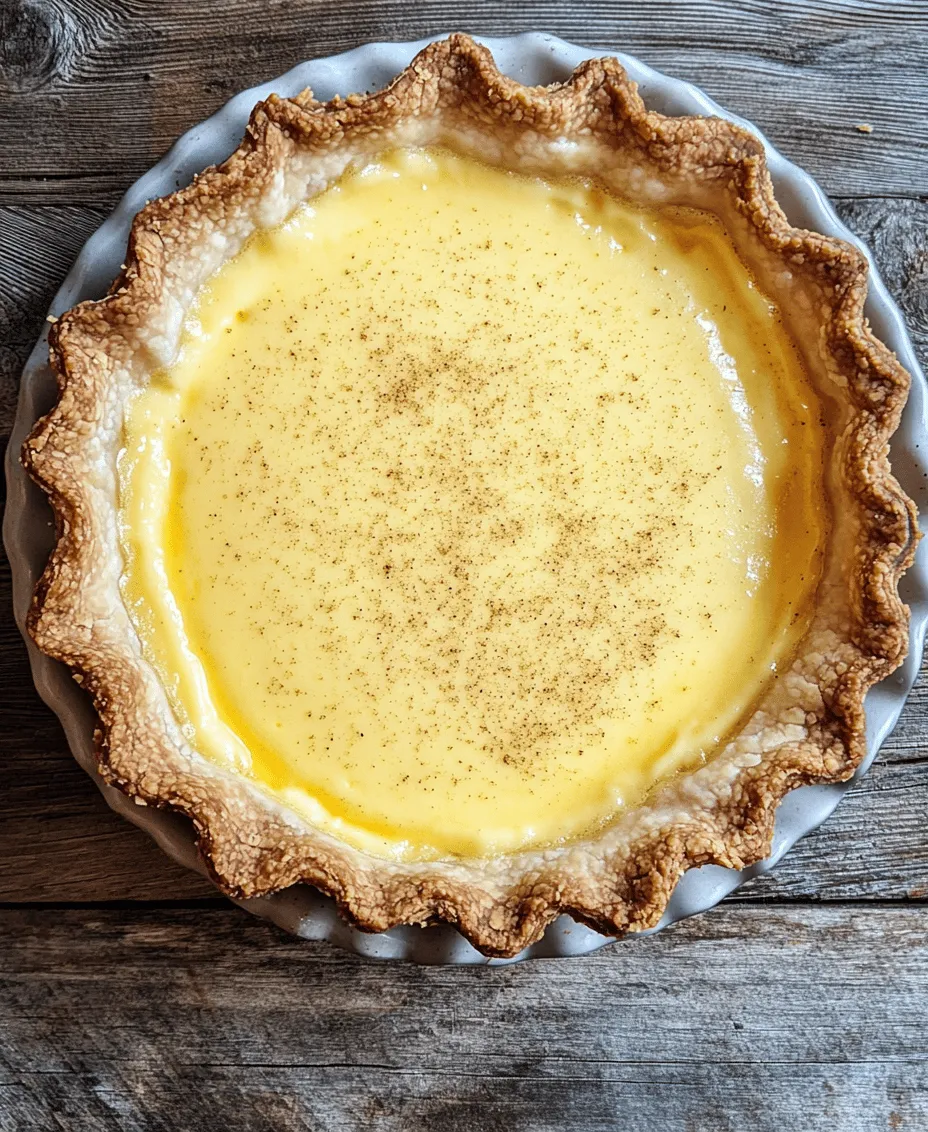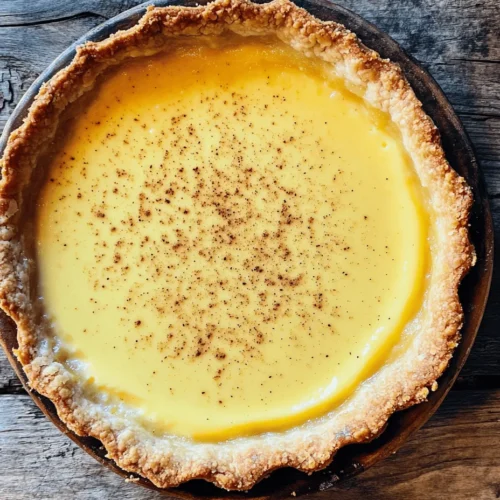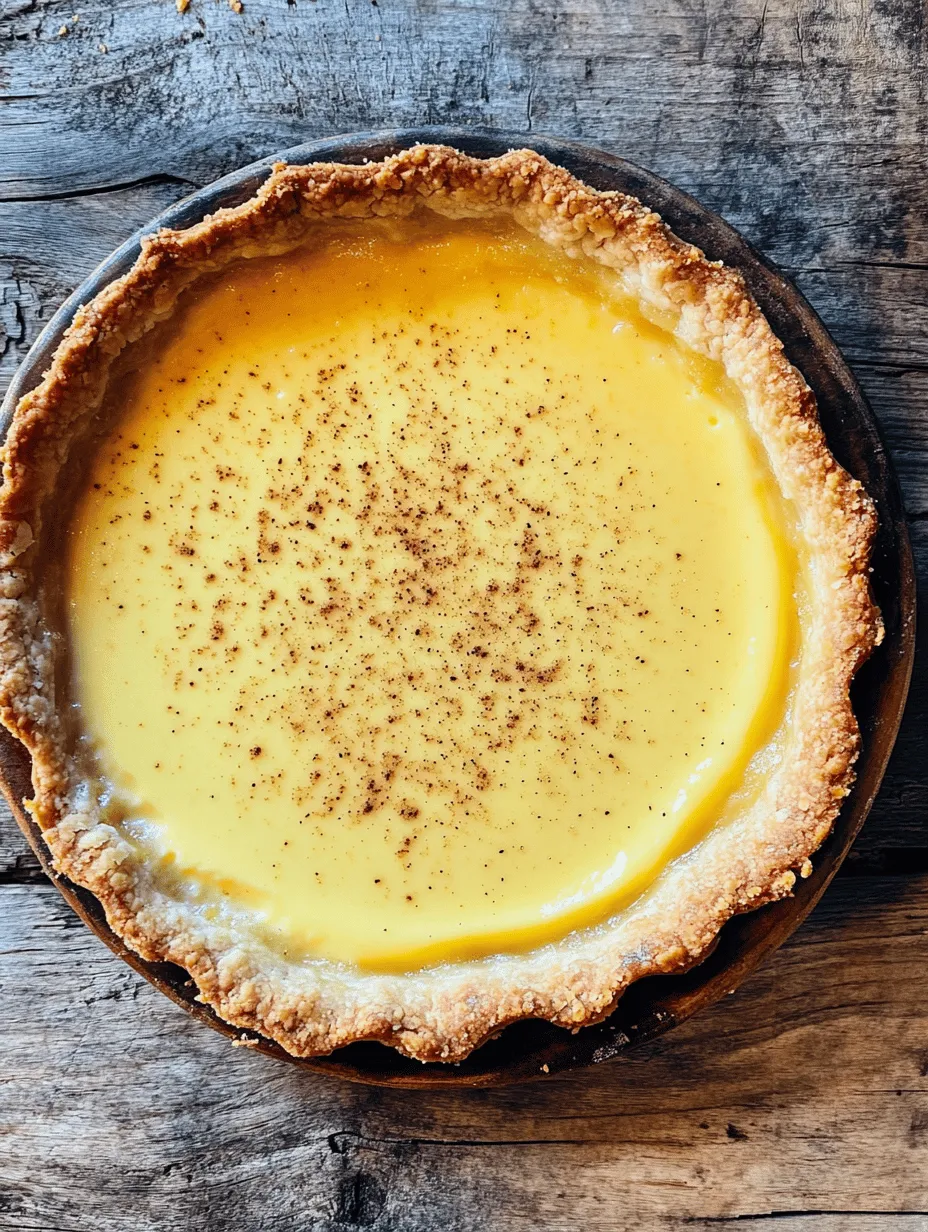The allure of a classic egg custard pie lies in its simplicity and comfort, making it a beloved dessert in many households. With its smooth, creamy filling and a perfectly baked crust, this Timeless Egg Custard Pie recipe is not only easy to prepare but also evokes nostalgia with every bite. Whether it’s served at family gatherings, celebrations, or as a comforting treat after dinner, this pie embodies the warmth of home cooking. In this article, we will explore the history behind egg custard pie, delve into the ingredients needed for this delightful treat, and provide a step-by-step guide to ensure your custard pie turns out perfectly every time.
The History of Egg Custard Pie
Understanding the roots of the egg custard pie adds depth to this beloved dessert. The origins of custard-based desserts can be traced back to medieval times when custards were often the highlight of royal feasts. These early versions were primarily savory, made with eggs, milk, and various spices. As time progressed, the sweet rendition of custard became popular, especially in Europe.
Variations of custard pies can be found across cultures and regions. In England, for instance, custard tarts are a traditional dessert, often enriched with cream and flavored with vanilla. Meanwhile, the French custard tart, known as “flan,” features a caramelized top and a rich, creamy filling. Each culture has put its unique spin on custard desserts, reflecting local tastes and available ingredients.
The evolution of the egg custard pie in American cuisine is particularly fascinating. It was brought to America by European settlers who adapted their recipes to include local ingredients. The simple combination of eggs, milk, and sugar, baked in a crust, proved to be a hit among families. Egg custard pie became a staple in American households, especially in the South, where it is often served as a comforting dessert at Sunday dinners and holiday gatherings.
Ingredients Overview
Now that we understand the rich history of egg custard pie, let’s take a closer look at each ingredient that makes this pie special. The quality of your ingredients can greatly impact the final result, so it’s important to choose wisely.
– Eggs: The star of the custard filling, eggs provide structure and creaminess to the pie. It’s best to use fresh, high-quality eggs for the best flavor and texture. Organic or farm-fresh eggs can elevate your pie, giving it a richer taste.
– Granulated Sugar: Sugar balances the richness of the custard, providing just the right amount of sweetness. While granulated sugar is traditional, you can experiment with different sugar types, such as brown sugar, for a caramel-like flavor.
– Whole Milk: This ingredient adds creaminess and richness to the custard. Whole milk, with its higher fat content, creates a velvety texture. For an even richer custard, you can substitute part of the milk with heavy cream.
– Nutmeg: A hint of spice that enhances the flavor profile of the custard. Nutmeg adds warmth and depth, complementing the sweetness. Freshly grated nutmeg is recommended for the best aroma and taste.
– Pie Crust: The foundation of the pie, the crust can be homemade or store-bought. A homemade pie crust offers a flaky texture and can be customized, while a store-bought option saves time. Whichever you choose, ensure it is of good quality for the best results.
Using high-quality ingredients is crucial for achieving the perfect custard pie. Fresh eggs, whole milk, and real vanilla can make a significant difference in flavor, elevating your dessert from ordinary to extraordinary.
Preparing for the Baking Process
An essential guide to setting up for a successful baking experience begins with preparation. Preheating the oven, greasing the pie dish, and preparing the pie crust are critical steps that should not be overlooked.
– Preheating the Oven: It’s important to preheat your oven to the correct temperature, usually around 350°F (175°C), before you start baking. This ensures that your pie cooks evenly and helps to achieve a beautifully set custard filling. An oven thermometer can be a helpful tool to ensure accuracy, as some ovens can be off by several degrees.
– Greasing the Pie Dish: To prevent the custard from sticking, lightly grease your pie dish. You can use butter or a non-stick cooking spray for this step. If you’re using a homemade crust, ensure it is properly fitted into the dish before greasing. This will allow for easy removal of the pie after baking.
– Preparing the Pie Crust: If you opt for a homemade pie crust, start by making the dough. Combine flour, salt, and cold butter until crumbly, then add ice water until the dough holds together. Roll it out and fit it into your pie dish, trimming any excess dough. For store-bought options, simply unroll the crust and fit it into the dish, crimping the edges as desired. Regardless of the method, blind-bake the crust for about 10 minutes before adding the custard filling, ensuring it stays crisp and flaky.
Creating the Custard Filling
Creating the custard filling is where the magic happens in your Timeless Egg Custard Pie. The process is simple yet requires attention to detail for a silky-smooth texture. Here’s a step-by-step walkthrough to guide you through making the custard filling.
1. Whisk Together the Eggs: In a mixing bowl, crack the fresh eggs and whisk them until they are well combined. Aim for a uniform mixture without any streaks of egg white or yolk. This ensures a smooth custard.
2. Add Sugar and Nutmeg: Gradually incorporate granulated sugar and a pinch of freshly grated nutmeg into the egg mixture. Continue whisking until the sugar is fully dissolved, and the mixture is pale and frothy.
3. Incorporate Milk: Slowly pour in the whole milk while whisking continuously. This gradual addition helps to temper the eggs, preventing them from scrambling. Ensure the mixture is well-blended and has a homogenous texture.
4. Strain the Mixture: For an ultra-smooth custard, strain the mixture through a fine-mesh sieve into another bowl or pitcher. This step removes any clumps or bits of cooked egg that may have formed, resulting in a silky filling.
5. Pour into the Crust: Carefully pour the custard filling into the prepared pie crust. Avoid splashing or overfilling; it’s best to leave a little space at the top to allow for any puffing during baking.
By following these steps, you’ll create a custard filling that is both rich and creamy, setting the foundation for a perfect Timeless Egg Custard Pie. The next steps will involve baking the pie to perfection, achieving that coveted golden top, and allowing it to set. Stay tuned for the continuation of this recipe, where we will cover the baking process and offer tips for serving this delectable dessert.

Whisking the Eggs: Tips for Achieving the Right Texture
Whisking the eggs is a crucial step in making a flawless egg custard pie. The goal here is to create a uniform mixture that is both smooth and airy, ensuring a light texture in the final pie. Start by using fresh, large eggs, as they provide the best flavor and texture for the custard. Crack the eggs into a mixing bowl, and with a whisk or an electric mixer, beat them vigorously until the yolks and whites are fully combined.
For a truly velvety custard, it’s essential not to over-whisk. Aim for a frothy but cohesive mixture; too much air can lead to bubbles that will disrupt the custard’s creamy consistency during baking. Incorporating air is beneficial, but moderation is key. If you’re using an electric mixer, whisk at a low to medium speed for about 2-3 minutes. This will give you the right balance of air while still maintaining a rich, custard-like texture.
Incorporating Sugar and Flavorings: Balancing Flavors
Once your eggs are whisked to perfection, it’s time to introduce the sugar and flavorings. Granulated sugar is the most common choice for sweetness, but feel free to experiment with alternatives like brown sugar or coconut sugar for a different flavor profile. Gradually add the sugar to the egg mixture while continuing to whisk. This gradual incorporation allows the sugar to dissolve properly, preventing any graininess in your custard.
In addition to sugar, you may wish to add flavorings such as vanilla extract or almond extract. A teaspoon of vanilla extract not only enhances the sweetness but also adds depth to the overall flavor. If you’re feeling adventurous, consider adding a hint of lemon or orange zest for a refreshing twist. Striking the right balance between sweetness and flavor is essential, so taste the mixture as you go, making adjustments to suit your palate.
The Role of Milk in Achieving a Creamy Consistency
The milk plays a pivotal role in creating the custard’s creamy texture. Whole milk is the best option, providing rich flavor and a smooth mouthfeel, but you can also use half-and-half or a combination of milk and cream for an even richer custard. When adding the milk to your egg and sugar mixture, do so gradually while whisking continuously. This technique helps to temper the eggs and prevents them from scrambling.
For the ultimate creaminess, heat the milk gently before adding it to the egg mixture. Warm milk incorporates more easily and helps to dissolve the sugar completely. You can also infuse the milk with additional flavors by heating it with spices like cinnamon or vanilla beans before whisking it into the custard. Just ensure to let the milk cool slightly before combining it with the eggs to avoid cooking them.
Adding Nutmeg: Enhancing Flavor Without Overpowering
Nutmeg is a classic spice used in egg custard pies, offering a warm, aromatic flavor that complements the sweetness of the custard beautifully. It’s important to use freshly grated nutmeg if possible, as it has a more vibrant flavor than pre-ground versions. Start with a small amount—about 1/4 teaspoon—because nutmeg can be quite potent, and you want it to enhance the custard rather than overpower it.
When adding nutmeg, sprinkle it into the custard mixture while whisking. This ensures even distribution throughout the pie. For those who enjoy a more pronounced spice flavor, feel free to adjust the amount to your liking, but moderation is key. The goal is to create a harmonious blend of flavors that will entice the palate without any single ingredient dominating the dish.
Assembling the Pie
Properly Filling the Pie Crust: Avoiding Spills and Overflow
With your custard mixture prepared, it’s time to assemble the pie. Ensure that your pie crust is pre-baked and cooled. If you’re using a store-bought crust, follow the package instructions for pre-baking. For homemade crusts, roll out your dough, fit it into the pie dish, and bake it until lightly golden.
When pouring the custard into the crust, do so slowly and carefully to avoid spills. It’s best to pour the custard into the center of the crust and allow it to gently spread out to the edges. This method helps to minimize splashing and keeps the custard from overflowing. If you’re concerned about spills, consider placing the pie dish on a baking sheet before filling it to catch any drips that may occur.
Techniques for Smoothing the Custard Mixture
Once the custard is poured into the crust, take a moment to smooth the mixture with a spatula or the back of a spoon. This is especially important if you notice any bubbles or lumps in the custard. Gently tapping the pie dish on the counter will also help release any trapped air bubbles, resulting in a smoother surface.
For an added touch, you might consider using a fine-mesh sieve to strain the custard mixture before pouring it into the crust. This step will catch any bits of coagulated egg or undissolved sugar, ensuring a silky-smooth custard that is free from imperfections.
Baking the Egg Custard Pie
Ideal Baking Time and Temperature: Ensuring a Perfectly Set Custard
Baking your egg custard pie requires attention to temperature and timing. Preheat your oven to 350°F (175°C), as this is the ideal temperature for gently setting the custard without curdling the eggs. Place the pie in the center of the oven and bake for about 40 to 50 minutes.
The custard should puff slightly and should be set around the edges but still have a slight jiggle in the center. This jiggle is a good sign that the custard will continue to set as it cools. Avoid overbaking, as this can lead to a rubbery texture in the final pie.
Signs That the Pie Is Ready: Testing for Doneness
To determine if your pie is ready, use a knife or a toothpick inserted into the center. If it comes out clean or with just a few moist crumbs attached, your custard is set. If it comes out with a wet custard mixture, it needs more time in the oven. Be cautious not to open the oven door too frequently, as this can cause the temperature to drop and lead to uneven baking.
Another method is to gently shake the pie; if the center jiggles slightly but doesn’t ripple, it’s a good indicator that it’s done. Remember, the pie will continue to cook slightly even after being removed from the oven due to residual heat.
The Importance of Cooling: Allowing the Pie to Set Properly
Once your pie has finished baking, it’s essential to allow it to cool properly. Remove it from the oven and let it sit at room temperature for at least 30 minutes. During this time, the custard will continue to set as it cools.
After cooling, transfer the pie to the refrigerator for at least two hours, or preferably overnight. This chilling time allows the flavors to meld and enhances the overall texture. Chilling also makes it easier to slice the pie neatly, ensuring that you serve perfect portions.
Chilling and Serving the Pie
Cooling at Room Temperature: Timing and Techniques
Cooling your egg custard pie at room temperature is an essential step in the preparation process. Allowing it to rest for about 30 minutes after baking ensures that it stabilizes. Placing the pie on a wire rack can help to dissipate heat evenly, preventing a soggy crust. Avoid covering the pie while it cools, as this can trap moisture and lead to condensation, which may affect the texture.
Chilling in the Refrigerator: Benefits of Serving Chilled
Chilling the egg custard pie not only enhances its flavor but also improves its texture. The custard firms up as it cools, making it easier to slice and serve. A well-chilled pie offers a refreshing contrast to the warm spices and sweetness of the custard, making it an ideal dessert for any occasion.
You can chill the pie covered with plastic wrap or aluminum foil, but be sure to do so gently to avoid disturbing the custard. If you have garnished the pie with nutmeg or other toppings, you may want to wait until just before serving to avoid any textural changes.
Garnishing with Nutmeg: Enhancing Presentation and Flavor
When it comes time to serve your egg custard pie, a final touch of freshly grated nutmeg will elevate both its presentation and flavor. Use a microplane or fine grater to sprinkle a light dusting of nutmeg over the top. This not only adds visual appeal but also enhances the aromatic qualities of the pie, inviting guests to dig in.
Nutritional Information
Understanding the nutritional value of your egg custard pie can be helpful, especially for those monitoring their dietary intake. On average, one slice (about 1/8 of the pie) contains approximately 250 calories.
Here’s a quick breakdown of the key nutrients per serving:
– Calories: 250
– Protein: 5 grams
– Fat: 12 grams
– Carbohydrates: 30 grams
– Sugars: 15 grams
This classic dessert is rich in flavor and provides a satisfying end to any meal. While it’s a treat best enjoyed in moderation, knowing its nutritional content can help you make informed choices.
Conclusion
The Timeless Egg Custard Pie is more than just a dessert; it is a celebration of simple ingredients coming together to create a dish that is both comforting and delicious. Perfect for family gatherings, holiday celebrations, or simply a cozy night in, this recipe invites you to savor each bite. With its rich history and straightforward preparation, the egg custard pie remains a cherished classic that has stood the test of time, making it a worthy addition to any recipe collection.
Whether enjoyed on its own or accompanied by a dollop of whipped cream, this pie embodies the essence of home cooking—nourishing, satisfying, and filled with love. So gather your ingredients, follow these steps, and enjoy the delightful experience of creating your very own egg custard pie.



